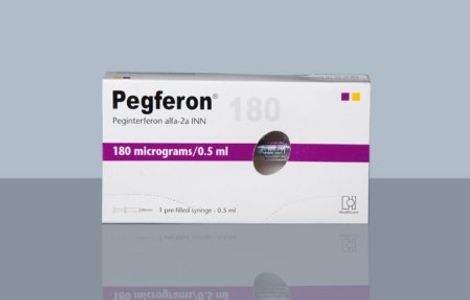Pegferon Uses, Dosage, Side Effects and more
Pegferon is a form of recombinant interferon used as part of combination therapy to treat chronic Hepatitis C, an infectious liver disease caused by infection with Hepatitis C Virus (HCV). HCV is a single-stranded RNA virus that is categorized into nine distinct genotypes, with genotype 1 being the most common in the United States, and affecting 72% of all chronic HCV patients . Treatment options for chronic Hepatitis C have advanced significantly since 2011, with the development of Direct Acting Antivirals (DAAs) resulting in less use of Pegferon. Pegferon is derived from the alfa-2a moeity of recombinant human interferon and acts by binding to human type 1 interferon receptors. Activation and dimerization of this receptor induces the body's innate antiviral response by activating the janus kinase/signal transducer and activator of transcription (JAK/STAT) pathway. Use of Pegferon is associated with a wide range of severe adverse effects including the aggravation and development of endocrine and autoimmune disorders, retinopathies, cardiovascular and neuropsychiatric complications, and increased risk of hepatic decompensation in patients with cirrhosis. The use of Pegferon has largely declined since newer interferon-free antiviral therapies have been developed.
In a joint recommendation published in 2016, the American Association for the Study of Liver Diseases (AASLD) and the Infectious Diseases Society of America (IDSA) no longer recommend Pegferon for the treatment of Hepatitis C . Pegferon was used alongside Ribavirin with the intent to cure, or achieve a sustained virologic response (SVR), after 48 weeks of therapy. SVR and eradication of HCV infection is associated with significant long-term health benefits including reduced liver-related damage, improved quality of life, reduced incidence of Hepatocellular Carcinoma, and reduced all-cause mortality .
Pegferon is available as a fixed dose injector (tradename Pegasys) used for the treatment of chronic Hepatitis C. Approved in 2002 by the FDA, Pegasys is indicated for the treatment of HCV with Ribavirin or other antiviral drugs . When combined together, Pegferon and Ribavirin have been shown to achieve a SVR between 36% for genotype 1 and 59% for genotypes 2-6 after 48 weeks of treatment.

| Attribute | Details |
|---|---|
| Trade Name | Pegferon |
| Generic | Peginterferon alfa-2a |
| Peginterferon alfa-2a Other Names | Peginterferon alfa-2a, Pegylated Interfeaon alfa-2A, Pegylated interferon alfa-2a, Pegylated interferon alpha-2a, Pegylated-interferon alfa 2a |
| Weight | 135mcg/0.5ml, 180mcg/0.5ml |
| Type | Sc Injection |
| Weight | 60000.0 Da |
| Groups | Approved, Investigational |
| Therapeutic Class | |
| Manufacturer | Healthcare Pharmacuticals Ltd |
| Available Country | Bangladesh |
| Last Updated: | January 7, 2025 at 1:49 am |
Uses
Pegferon is a modified form of recombinant human interferon used to stimulate the innate antiviral response in the treatment of hepatitis B and C viruses.
Pegferon is indicated for the treatment of HCV in combination with other antiviral drugs in patients over 5 years of age with compensated liver disease . May be used as a monotherapy in patients with contraindications to or significant intolerance to other anti-viral therapies.
Pegferon is also indicated as a monotherapy for adult patients with HBeAg positive and HBeAg negative chronic hepatitis B infection who have compensated liver disease and evidence of viral replication and liver inflammation .
Pegferon is also used to associated treatment for these conditions: Hepatitis B Chronic Infection, Compensated liver disease
How Pegferon works
Pegferon is derived from recombinant human interferon's alfa-2a moeity . It binds to and activates human type 1 interferon receptors causing them to dimerize. This activates the JAK/STAT pathway. Activation of the JAK/STAT pathway increases expression of multiple genes in multiple tissues involved in the innate antiviral response.
How Long Does It Take to Work?
How Long Does It Take to Work? see here Pegferon
Toxicity
Pegferon may manifest neuropsychiatric complications include suicide, suicidal ideation, homicidal ideation, depression, relapse of drug addiction, and drug overdose . Hypertension, supraventricular arrhythmias, chest pain, and myocardial infarction have been observed in patients using Pegferon. Pegferon may produce myelosuppression as well as the development or aggravation of autoimmune disorders including myositis, hepatitis, thrombotic thrombocytopenic purpura, idiopathic thrombocytopenic purpura, psoriasis, rheumatoid arthritis, interstitial nephritis, thyroiditis, and systemic lupus erythematosus. Pegferon causes or aggravates hypothyroidism and hyperthyroidism. Hyperglycemia, hypoglycemia, and diabetes mellitus have been observed to develop in patients treated with Pegferon. Pegferon may decrease or produce loss of vision, retinopathy including macular edema, retinal artery or vein thrombosis, retinal hemorrhages and cotton wool spots, optic neuritis, papilledema and serous retinal detachment. Peginterferon mayy be related to increased ischemic and hemorrhagic cerebrovascular events. Patients with cirrhosis on Pegferon are at risk of hepatic decompensation. Dyspnea, pulmonary infiltrates, pneumonia, bronchiolitis obliterans, interstitial pneumonitis, pulmonary hypertension and sarcoidosis may be induced or aggravated by Pegferon. Serious and severe infections (bacterial, viral, or fungal) have been reported during treatment with Pegferon. Ulcerative and hemorrhagic/ischemic colitis have been observed within 12 weeks of starting Pegferon treatment. Pancreatitis and peripheral nephropathy have also been reported. Pegferon is associated with growth inhibition in pediatric patients. Use of Pegferon while pregant may result in delopmental abnormalities or death of the fetus.
Food Interaction
- Drink plenty of fluids.
Elimination Route
Pegferon reaches peak plasma concentration 72-96 hours after subcutaneous administration . Trough concentrations at week 48 are approximately 2 fold higher than week 1. The peak to trough ratio at week 48 is 2.
Half Life
The mean terminal half-life of peginterferon alfa-2a is 164 in a range of 84-353 hours .
Clearance
The mean systemic clearance of peginterferon alfa-2a is 94 milliliters per hour .



